《电磁学》课程教学资源(拓展资料)Exam and Solutions Exam 2 Practice Problems Part 1 Solutions
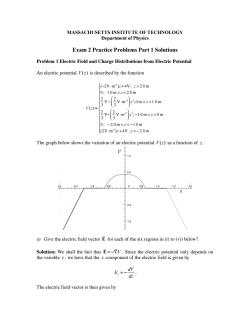
MASSACHUSETTS INSTITUTE OF TECHNOLOGY Department of Physics Exam 2 Practice Problems Part 1 Solutions Problem 1 Electric Field and Charge Distributions from Electric Potential An electric potential V(z)is described by the function (-2Vm)z+4V;z>2.0m 0;1.0m<z<2.0m 八3 (2 Vm33,0m<z<1.0m 3 V(z)= 2 V+ 2vm3-10m<:<0m 3 0;-2.0m<z<-1.0m (2Vm)z+4V;z<-2.0m The graph below shows the variation of an electric potential V()as a function of z. V 1.6 08 -24 -16 08 0 08 1.6 24 3 -0.8 -1.6 a)Give the electric field vector E for each of the six regions in (i)to (vi)below? Solution:We shall the fact that E=-VV.Since the electric potential only depends on the variable z,we have that the z-component of the electric field is given by Es、d业 dz The electric field vector is then given by
MASSACHUSETTS INSTITUTE OF TECHNOLOGY Department of Physics Exam 2 Practice Problems Part 1 Solutions Problem 1 Electric Field and Charge Distributions from Electric Potential An electric potential V (z) is described by the function V (z) = (!2V"m-1 )z + 4V ; z > 2.0 m 0 ; 1.0 m < z < 2.0 m 2 3 V ! 2 3 V"m-3 # $ % & ' ( z3 ; 0 m < z <1.0 m 2 3 V+ 2 3 V"m-3 # $ % & ' ( z3 ; !1.0 m < z < 0 m 0 ; ! 2.0 m < z < !1.0 m (2V"m-1 )z + 4V ; z < ! 2.0 m ) * + + + + + , + + + + + The graph below shows the variation of an electric potential V (z) as a function of z . a) Give the electric field vector E ! for each of the six regions in (i) to (vi) below? Solution: We shall the fact that E = !"V ! ! . Since the electric potential only depends on the variable z , we have that the z -component of the electric field is given by z dV E dz = ! . The electric field vector is then given by

E=E.i=-dVk dz (iz>2.0m: E=-dk=-4(-2V-m)z+4v)k=2V.m8 dz d (ii)1.0m0 is a very small number is given by E-=(2V.mX(lm)k=2Vk m Note that the z-component of the electric field,2 V.m,has the correct units. (iv)-1.0m<z<0m: E=vm月 =-(2Vm)k The value of the electric field at a point just inside z*=-1.0 m+g m is given by E-=-(2V.mXlm)k=-2Yk. m (v)-2.0m<z<-1.0m: E=-k=0 d (vi)z<-2.0m: EV.m)+4V)--2V-m'k dz
ˆ ˆ z dV E dz E = i = ! k ! (i) z > 2.0 m : ( ) -1 -1 ˆ ˆ ˆ ( 2V m ) 4V 2V m dV d z dz dz E = ! k = ! ! " + k = " k ! (ii) 1.0 m 0 is a very small number is given by ! E! = (2 V"m-3 )(1m) 2 kˆ = 2 V m kˆ Note that the z-component of the electric field, 2 V!m"1 , has the correct units. (iv) −1.0 m 0 m < <z : ! E = ! dV dz kˆ = ! d dz 2 3 V+ 2 3 V"m-3 # $ % & ' ( z 3 # $ % & ' ( kˆ = ! 2 V"m-3 ( )z 2 kˆ The value of the electric field at a point just inside z+ = !1.0 m + " m is given by ! E! = !(2 V"m-3 )(1m) 2 kˆ = !2 V m kˆ . (v) −2.0 m 1.0 m < <z − : ˆ dV dz E = ! k = 0 ! ! (vi) z < ! 2.0 m : ( ) -1 -1 ˆ ˆ ˆ (2V m ) 4V 2V m dV d z dz dz E = ! k = ! " + k = ! " k !

b)Make a plot of the z-component of the electric field,E.,as a function of z.Make sure you label the axes to indicate the numeric magnitude of the field. E:2 2.0 [V/m].e 08 04 08 12 18 24 z m -2.0 c)Qualitatively describe the distribution of charges that gives rise to this potential landscape and hence the electric fields you calculated.That is,where are the charges, what sign are they,what shape are they (plane,slab...)? In the region -1.0 m2.0 m (hence the positive component of the electric field). On the plane =1.0 m,there is a negative uniform charge density -o. In the region -2.0 m<z<-1.0 m there is a conductor where the field is zero. On the plane z=-2.0 m,there is a positive uniform charge density o that produces a constant field pointing to the left in the region z<-2.0 m (hence the positive component of the electric field). On the plane z=-1.0 m,there is a negative uniform charge density -o
b) Make a plot of the z-component of the electric field, Ez , as a function of z. Make sure you label the axes to indicate the numeric magnitude of the field. c) Qualitatively describe the distribution of charges that gives rise to this potential landscape and hence the electric fields you calculated. That is, where are the charges, what sign are they, what shape are they (plane, slab…)? In the region !1.0 m 2.0 m (hence the positive component of the electric field). On the plane z =1.0 m , there is a negative uniform charge density "! . In the region !2.0 m < z < !1.0 m there is a conductor where the field is zero. On the plane z = ! 2.0 m , there is a positive uniform charge density ! that produces a constant field pointing to the left in the region z < ! 2.0 m (hence the positive component of the electric field). On the plane z = !1.0 m, there is a negative uniform charge density "!

Problem 2:Electric Field from Electric Potential The electric potential V(x)for a planar charge distribution is given by: 0 forxd where -V is the potential at the origin and d is a distance. V(x) 0 25 This function is plotted to the right,with d=2cm and =2V,the x-axis with units in cm,the y-axis in units of Volts. (a)What is the electric field E(x)for this problem? Region I:x<-d E=-7v=- vi=0 Region II:-d≤x<0 -
Problem 2: Electric Field from Electric Potential The electric potential V (x) for a planar charge distribution is given by: V (x) = 0 for x d ) * + + + + , + + + + where !V0 is the potential at the origin and d is a distance. This function is plotted to the right, with d = 2 cm and V0 = 2 V , the x-axis with units in cm, the y-axis in units of Volts. (a) What is the electric field ! E(x) for this problem? Region I: x < -d ! E = !"V = ! #V #x ˆ i = 0 Region II: !d " x < 0 ! E = ! " "x !V0 1+ x d # $ % & ' ( 2 # $ % % & ' ( ( ˆ i = 2 V0 d 1+ x d # $ % & ' ( ˆ i

Region III:0≤xd =-VV= avi-0 Ox (b)Plot the electric field that you just calculated on the graph below.Be sure to properly label the y-axis(top and bottom)to indicate the limits of the magnitude of the E field! E,(x) This makes sense.Where the potential is flat,the E field is 0
Region III: 0 ! x d ! E = !"V = ! #V #x ˆ i = 0 (b) Plot the electric field that you just calculated on the graph below. Be sure to properly label the y-axis (top and bottom) to indicate the limits of the magnitude of the E field! This makes sense. Where the potential is flat, the E field is 0
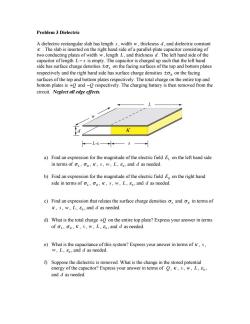
Problem 3 Dielectric A dielectric rectangular slab has length s,width w,thickness d,and dielectric constant K.The slab is inserted on the right hand side of a parallel-plate capacitor consisting of two conducting plates of width w,length L,and thickness d.The left hand side of the capacitor of length L-s is empty.The capacitor is charged up such that the left hand side has surface charge densities +o,on the facing surfaces of the top and bottom plates respectively and the right hand side has surface charge densities tog on the facing surfaces of the top and bottom plates respectively.The total charge on the entire top and bottom plates is +0 and-O respectively.The charging battery is then removed from the circuit.Neglect all edge effects. Ls一s→ a)Find an expression for the magnitude of the electric field E on the left hand side in terms of o,og,K,s,w,L,and d as needed b)Find an expression for the magnitude of the electric field Eg on the right hand side in terms of o.og,K,s,w,L,8,and d as needed. c)Find an expression that relates the surface charge densities o,and og in terms of K,s,w,L,8,and d as needed. d)What is the total charge +0 on the entire top plate?Express your answer in terms of oL,oR,K,s,w,L,Eo,and d as needed. e)What is the capacitance of this system?Express your answer in terms of K,s, w,L,and d as needed. f)Suppose the dielectric is removed.What is the change in the stored potential energy of the capacitor?Express your answer in terms of K,s,w,L,E, and d as needed
Problem 3 Dielectric A dielectric rectangular slab has length s, width w , thickness d , and dielectric constant ! . The slab is inserted on the right hand side of a parallel-plate capacitor consisting of two conducting plates of width w , length L , and thickness d . The left hand side of the capacitor of length L ! s is empty. The capacitor is charged up such that the left hand side has surface charge densities ±! L on the facing surfaces of the top and bottom plates respectively and the right hand side has surface charge densities ±! R on the facing surfaces of the top and bottom plates respectively. The total charge on the entire top and bottom plates is +Q and !Q respectively. The charging battery is then removed from the circuit. Neglect all edge effects. a) Find an expression for the magnitude of the electric field EL on the left hand side in terms of ! L , ! R , ! , s, w , L , ! 0 , and d as needed. b) Find an expression for the magnitude of the electric field ER on the right hand side in terms of ! L , ! R , ! , s, w , L , ! 0 , and d as needed. c) Find an expression that relates the surface charge densities ! L and ! R in terms of ! , s, w , L , ! 0 , and d as needed. d) What is the total charge +Q on the entire top plate? Express your answer in terms of ! L , ! R , ! , s, w , L , ! 0 , and d as needed. e) What is the capacitance of this system? Express your answer in terms of ! , s, w , L , ! 0 , and d as needed. f) Suppose the dielectric is removed. What is the change in the stored potential energy of the capacitor? Express your answer in terms of Q , ! , s, w , L , ! 0 , and d as needed
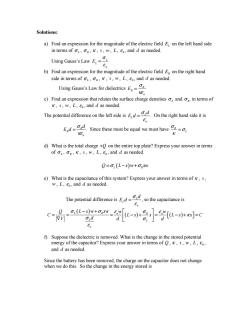
Solutions: a)Find an expression for the magnitude of the electric field E,on the left hand side in terms of o,og,K,s,w,L,and d as needed. Using Gauss's LawE b)Find an expression for the magnitude of the electric field Eg on the right hand side in terms of o,og,K,s,w,L,8,and d as needed. Using Gauss's Law for dielectrics E E c)Find an expression that relates the surface charge densities o,and og in terms of K,s,w,L,and d as needed. The potential differencen the le side isEOn the right hand side it is Ed Since these must be equal we must have E。 d)What is the total charge +0 on the entire top plate?Express your answer in terms of o,og,K,s,w,L,E,and d as needed. =0(L-s)w+oRSw e)What is the capacitance of this system?Express your answer in terms of K,s, w,L,o,and d as needed. The potential difference is Edd -so the capacitance is C=_ -2u-[u-4]-c od f)Suppose the dielectric is removed.What is the change in the stored potential energy of the capacitor?Express your answer in terms of K,s,w,L,8, and d as needed. Since the battery has been removed,the charge on the capacitor does not change when we do this.So the change in the energy stored is
Solutions: a) Find an expression for the magnitude of the electric field EL on the left hand side in terms of ! L , ! R , ! , s, w , L , ! 0 , and d as needed. Using Gauss’s Law EL = ! L " o b) Find an expression for the magnitude of the electric field ER on the right hand side in terms of ! L , ! R , ! , s, w , L , ! 0 , and d as needed. Using Gauss’s Law for dielectrics R R o E σ κε = c) Find an expression that relates the surface charge densities ! L and ! R in terms of ! , s, w , L , ! 0 , and d as needed. The potential difference on the left side is L L o d E d σ ε = . On the right hand side it is R R o d E d σ κε = . Since these must be equal we must have R L σ σ κ = d) What is the total charge +Q on the entire top plate? Express your answer in terms of ! L , ! R , ! , s, w , L , ! 0 , and d as needed. Q L s w sw =σ σ L R ( − ) + e) What is the capacitance of this system? Express your answer in terms of ! , s, w , L , ! 0 , and d as needed. The potential difference is L L o d E d σ ε = , so the capacitance is ( ) ( ) ( ) L R o o R L L o Q L s w sw w w C Ls s Ls s C V dd d σ σ ε ε σ κ σ σ ε − + ⎡ ⎤ == = ⎢ ⎥ − + = ⎡ ⎤ − + = ⎣ ⎦ ∇ ⎣ ⎦ f) Suppose the dielectric is removed. What is the change in the stored potential energy of the capacitor? Express your answer in terms of Q , ! , s, w , L , ! 0 , and d as needed. Since the battery has been removed, the charge on the capacitor does not change when we do this. So the change in the energy stored is
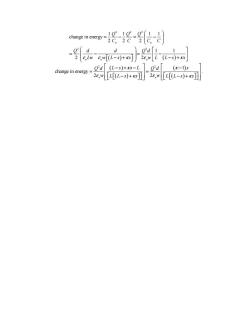
enag是-是-- d e定g亿-+sg4H 1 28w L (L-s)+ks change in energy= oa( od (K-1)s 2ew[[(L-s)+]
( ) ( ) 2 22 2 2 1 1 11 change in energy 22 2 1 1 2 2 o o o o o Q QQ C C CC Q d d Qd ε εκ Lw w L L s s ε κ wLs s ⎛ ⎞ = − = ⎜ ⎟ − ⎝ ⎠ ⎛ ⎞ ⎡ ⎤ = ⎜ ⎟ − = ⎢ ⎥ − ⎡ ⎤ − + − + ⎝ ⎠ ⎣ ⎦ ⎣ ⎦ ( ) ( ) ( ) ( ) 2 2 1 change in energy 2 2 o o Qd Qd Ls sL s w w LLs s LLs s κ κ ε ε κ κ ⎡ ⎤⎡ ⎤ − + − − = = ⎢ ⎥⎢ ⎥ ⎢ ⎥⎢ ⎥ ⎡ ⎤⎡ ⎤ ⎡⎤ ⎡⎤ − + − + ⎣ ⎦⎣ ⎦ ⎣ ⎦⎣ ⎦ ⎣⎦ ⎣⎦
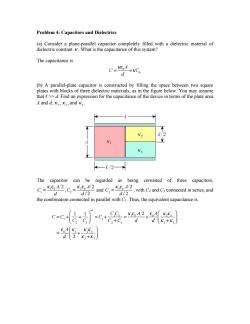
Problem 4:Capacitors and Dielectrics (a)Consider a plane-parallel capacitor completely filled with a dielectric material of dielectric constant k.What is the capacitance of this system? The capacitance is C=K d -=KCo (b)A parallel-plate capacitor is constructed by filling the space between two square plates with blocks of three dielectric materials,as in the figure below.You may assume that t>>d.Find an expression for the capacitance of the device in terms of the plate area A and d,K,K,,and K3. K2 d/2 K 业 K3 —0/2 The capacitor can be regarded as being consisted of three capacitors, C-K6 4/2.C,=K 4/2 d d/2 and C=Ke 4/2 with C and C3 conected in series,and the combination connected in parallel with C1.Thus,the equivalent capacitance is c-c-c+62 +
Problem 4: Capacitors and Dielectrics (a) Consider a plane-parallel capacitor completely filled with a dielectric material of dielectric constant κ . What is the capacitance of this system? The capacitance is C = !" 0A d =!C0 (b) A parallel-plate capacitor is constructed by filling the space between two square plates with blocks of three dielectric materials, as in the figure below. You may assume that ℓ >> d. Find an expression for the capacitance of the device in terms of the plate area A and d, ! 1 , ! 2 , and ! 3 . The capacitor can be regarded as being consisted of three capacitors, C1 = ! 1 " 0 A 2 d ,C2 = ! 2 " 0 A 2 d / 2 and C3 = ! 3 " 0 A 2 d / 2 , with C2 and C3 connected in series, and the combination connected in parallel with C1. Thus, the equivalent capacitance is C = C1 + 1 C2 + 1 C3 ! " # $ % & '1 = C1 + C2 C3 C2 + C3 = ( 1 ) 0 A 2 d + ) 0A d ( 2 ( 3 ( 2 +( 3 ! " # $ % & = ) 0A d ( 1 2 + ( 2 ( 3 ( 2 +( 3 ! " # $ % &

Problem 5:Conductors and Potential A charge-O is at the center of a neutral metal(conducting)sphere of radius R that is in turn centered in a larger metal (conducting)sphere of radius R,which carries a net charge of +O.The potentials of the inner and outer spheres with respect to infinity are respectively: +6 01 - Inner Outer A.kO( 1 B.-k B Q 0 C.0, R D.k.O( 1 0 ,R Explain your reasoning. Reason:The induced charge distributions are shown in the figure below.The overall charge is zero,so there is not charge on the outer surface of the outer sphere
Problem 5: Conductors and Potential A charge !Q is at the center of a neutral metal (conducting) sphere of radius R1 that is in turn centered in a larger metal (conducting) sphere of radius R2 , which carries a net charge of +Q. The potentials of the inner and outer spheres with respect to infinity are respectively: Inner Outer A. ke Q( 1 R2 ! 1 R1 ) ke Q R2 B. !ke Q R1 0 C. 0, ke Q( 1 R1 ! 1 R2 ) D. ke Q( 1 R2 ! 1 R1 ) 0 Explain your reasoning. Reason: The induced charge distributions are shown in the figure below. The overall charge is zero, so there is not charge on the outer surface of the outer sphere
按次数下载不扣除下载券;
注册用户24小时内重复下载只扣除一次;
顺序:VIP每日次数-->可用次数-->下载券;
- 《电磁学》课程教学资源(拓展资料)Exam and Solutions Exam 1 Practice Problems Solutions.pdf
- 《电磁学》课程教学资源(拓展资料)MIT-ED Classical Electrodynamics.pdf
- 《电磁学》课程教学资源(拓展资料)Exam and Solutions Exam One Solutions.pdf
- 《电磁学》课程教学资源(拓展资料)EM application Electroquasistatic and Magnetoquasistatic Fields and Boundary Conditions.pdf
- 《电磁学》课程教学资源(拓展资料)EM application Method of Images.pdf
- 《电磁学》课程教学资源(拓展资料)EM application Polarization and Conduction.pdf
- 《电磁学》课程教学资源(拓展资料)EM application Magnetization.pdf
- 《电磁学》课程教学资源(拓展资料)EM application Magnetoquasistatic Forces.pdf
- 《电磁学》课程教学资源(拓展资料)EM application Electroquasistatic Forces.pdf
- 《电磁学》课程教学资源(拓展资料)EM application Chapter 1 Fields.pdf
- 《电磁学》课程教学资源(教材讲义)麦克斯韦方程组 Chapter 13 Maxwell’s Equations and Electromagnetic Waves.pdf
- 《电磁学》课程教学资源(教材讲义)磁场的能量 Chapter 11 Inductance and Magnetic Energy.pdf
- 《电磁学》课程教学资源(教材讲义)交流电 Chapter 12 Alternating-Current Circuits.pdf
- 《电磁学》课程教学资源(教材讲义)稳恒电流 Chapter 7 DC Circuits.pdf
- 《电磁学》课程教学资源(教材讲义)静电场中的导体与电介质 Chapter 5 Capacitance and Dielectrics.pdf
- 《电磁学》课程教学资源(教材讲义)静电场中的导体与电介质 Chapter 5 Capacitance and Dielectrics.pdf
- 《电磁学》课程教学资源(教材讲义)真空中的静电场(光子质量)Terrestrial and Extraterrestrial Limits on The Photon Mass.pdf
- 《电磁学》课程教学资源(教材讲义)真空中的静电场(库仑定理)Physical implications of Coulomb’s Law.pdf
- 《电磁学》课程教学资源(教材讲义)真空中的静电场 Chapter 3 Electric Potential.pdf
- 《电磁学》课程教学资源(教材讲义)库仑定律验证 Improved result for the accuracy of Coulomb's law:A review of the Williams, Faller, and Hill experiment.pdf
- 《电磁学》课程教学资源(拓展资料)麦克斯韦方程和规范理论的观念起源(杨振宁)maxwell-y.pdf
- 《电磁学》课程教学资源(拓展资料)MIT-ID Interference and Diffraction.pdf
- 中国科学技术大学:《电磁学》课程教学资源(专题报告)超导电性与磁性.pdf
- 中国科学技术大学:《电磁学》课程教学资源(专题报告)等离子体物理及应用.ppt
- 中国科学技术大学:《电磁学》课程教学资源(专题报告)反物质探索(主讲:叶邦角).pdf
- 中国科学技术大学:《电磁学》课程教学资源(专题报告)铁电物理研究新进展 New Progress in Ferroelectrics(主讲:王忆).ppt
- 中国科学技术大学:《电磁学》课程教学资源(专题报告)加速器与同步辐射(主讲:戚伯云).ppt
- 中国科学技术大学:《电磁学》课程教学资源(专题报告)物质的磁性及其应用(主讲:张泰永).ppt
- 中国科学技术大学:《电磁学》课程教学资源(专题报告)Using Multi-gap Resistive Plate Chamber as TOF.ppt
- 中国科学技术大学:《电磁学》课程教学资源(专题报告)单原子分子测控(主讲:徐春凯).ppt
- 中国科学技术大学:《电磁学》课程教学资源(专题报告)只是应用于iPOD的GMR——漫谈2007诺贝尔物理奖(主讲:朱弘).ppt
- 中国科学技术大学:《电磁学》课程教学资源(专题报告)表面分析中的电与磁(主讲:张增明).pdf
- 中国科学技术大学:《电磁学》课程教学资源(专题报告)巨磁电阻效应及应用(主讲:李晓光).pdf
- 中国科学技术大学:《物理学》课程教学资源(科普报告)核物理与核技术的发展与应用(主讲:叶邦角).pdf
- 中国科学技术大学:《物理学》课程教学资源(科普报告)反物质探索.pdf
- 中国科学技术大学:《物理学》课程教学资源(科普报告)正电子在材料科学中的应用.pdf
- 中国科学技术大学:《物理学》课程教学资源(科普报告)医学物理的发展与展望(我国医学物理发展的思考).pdf
- 中国科学技术大学:《Muon物理》课程教学讲稿(技术及其应用)第一讲 Muon的基本慨况(主讲:陈祥磊)μ(muon)子简介.pdf
- 中国科学技术大学:《Muon物理》课程教学讲稿(技术及其应用)第二讲 慢正Muon束的产生 Low energy positive muons beam.pdf
- 中国科学技术大学:《正电子物理》课程教学讲稿(正电子在材料科学中的应用)01 正电子概况(1/2,主讲:叶邦角).pdf
